SUNDAY
APRIL 29 - 2018
Bumblebee
embroidery
One of the
many exhibits that caught my attention at the Emsworth
Arts Trail in the Emsworth Community Centre this
weekend was a beautifully embroidered Bumblebee by
Eloise Biddlecombe. Eloise told me she had taken the
image from the internet and did not know the species,
but every detail of the insect was done so perfectly
that identification should be easy.

I took a photo to
check at home and I am fairly sure it is Buff-tailed
Bumblebee (Bombus terrestris) which is
one of the most common Bumblebee species in this
country. My only reservation concerned a small area of
yellow where the black of the abdomen met the white of
the tail which suggested a Cuckoo species, but I think
my initial identification is probably the best
one.
Eloise's embroidery will be on show next weekend at
the Tuppenny Barn on the main road east of
Emsworth.
The Emsworth Arts Trail continues May 5, 6 and 6.
Details at . . . http://emsworthartstrail.org.uk/
Sedge
Warblers
In response to
my request for sightings of Sedge Warblers in
yesterday's blog, John Arnott replied to say about 6
Sedge Warblers were heard singing in the reedbeds
between the North Thorney track and Little Deep during
his bird song walk for the Conservancy on 22nd April.
They also got good views of three of them while they
were singing and showing their distinctive pale
'eyebrows'. Good to know they have arrived
successfully. They must have been quiet during my
visit.
Note, Sedge Warblers
usually frequent scrub and bramble rather than reeds
which are the habitat of Reed Warbler. Their songs are
easy to confuse, but the Reed Warbler has a slow
monotonous chur-chur-chur song whereas the Sedge
Warbler's song is much livelier and more musical. As
John indicated the Sedge Warbler also has a
distinctive white 'eyebrow' which the plain looking
Reed Warbler lacks.
Sedge
Warbler by Colin Vanner . . . . . . . Reed Warbler by
Richard Somerscocks
Dead
coot on millpond
Chris Oakley
found this very sad sight at the south west corner of
the town millpond this morning. It appears that the
Coot's neck is twisted around and there is a wound on
the throat. Chris suspects one of the resident Mute
Swans. However, swans usually only attack other swans.
Any other theories?

SATURDAY
APRIL 28 - 2018
News
from Langstone millpond
After a week
of short visits to the Langstone Mill Pond, Peter
Milinets-Raby says the situation at his end of
Emsworth Harbour is a bit on the dire side. The
highlights of the week are as follows:
The pair of Mute Swan have definitely given up
on their nest, it looks abandoned and today a few
Mallard were sleeping on it (probably for
warmth!).
The Little Egret colony has not made any
progress over the week. There are still approximately
21 to possibly 23+ nests with sitting adults (just ONE
on the island - there are usually 10 to 13 pairs on
the island!). I know we haven't entered into the month
of May yet, but I doubt if the numbers are going to
double to get to last years breeding numbers! I wonder
how many pairs have wandered over to Thorney Island
and is there another undiscovered colony somewhere
else? On Hayling Island perhaps?
On positive notes, singing Reed Warblers
increased to three birds today, with the Cetti's
Warbler still belting out its short explosive song. At
least two each of singing Chiffchaff and Blackcap and
a lingering pair of Tufted Duck were on the pond. A
pair of Gadwall was feeding on the last trickle of
water on the paddock (these birds must breed nearby on
the stream or in the small lake of the Wade Court
Complex).
The Grey Herons are getting very noisy now that
young and juveniles are milling about. Nest 5 has two
young in it.
Off shore, the four Great Crested Grebe were still
together, along with the five Shelduck.
On Friday I checked on
the gulls nesting on the roof of the old Colt building
along New Road, Havant. There were 22+ pairs of
Herring Gull and only 2 pairs of Lesser Black-backed
Gull. The Great Black-backed Gull pair could not be
seen. The complex is in the process of being knocked
down, so maybe the disturbance has deterred the GBB
Gulls. I hope the contractors leave the gull colony
alone, but I should imagine they will turn a blind eye
to the nesting birds and demolish the lot!! It will be
a shame to loose this colony.
Sedge
Warblers?
I had a walk
along the North Thorney track from Thornham Lane and
down the west side of Thorney Island as far as Little
Deeps yesterday. Cetti's Warbler and Reed Warbler were
both singing well, but no sight or sound from Sedge
Warbler. This is surprising as I always understood
that Sedge arrived before Reed. Has anyone had Sedge
Warbler this year?
First
Cuckoo at Chidham
Susan Kelly
had the good fortune to hear her first Cuckoo this
morning as she was passing Maybush Coppice on Cut Lane
in Chidham. 'And a noisy bird it was too'. Is this the
first local Cuckoo?
FRIDAY
APRIL 27 - 2018
Brook
Meadow sedges
I went over to
the meadow today mainly to look for sedges which have
been especially slow in coming through this year.
Brook Meadow is well known for its good variety of
sedges; there are 15 on the current list, though not
all are found every year and some are much harder to
find than others. All the more interesting sedges grow
on the Lumley area and four can be seen particularly
well at the moment: these are Divided Sedge, Distant
Sedge, Glaucous Sedge and Greater Pond Sedge. These
sedges are about 2 weeks later than in most previous
years, but are now well out. So, this maybe a good
opportunity to hone your sedge identification skills.
Divided Sedge
(Carex divisa) is the most important
sedge botanically on Brook Meadow and is classified as
nationally scarce. Its presence on Brook Meadow was
the main factor in the site being designated a Site of
Importance for Nature Conservation (SINC). Divided
Sedge grows densely on the eastern sector of the
Lumley area where it dominates all other sedges. It
can be identified by its single oval-shaped
inflorescence, with male and female spikelets
clustered together, at the top of a long thin stem,
often with a bract protruding above the flowers. This
bract can be seen in the right side plant in the
photo.
Distant Sedge
(Carex distans) differs from Divided
Sedge in that it tends to grow in tufts with several
plants clustered together. Also, in Distant Sedge the
cigar-shaped male and female spikelets are separated
(or distant) with one male spikelet at the top of the
stem and 1-3 female spikelets at intervals below.

Glaucous Sedge
(Carex flacca) grows mainly in the
centre of the Lumley area around grid ref SU 75127
06037 where one can find about 100 plants in a small
area - I have marked it with a stick. As its name
suggests Glaucous Sedge is looks greyish in colour. In
fact, if you look closely, only the underside of the
leaves is glaucous whereas the upperside is green.
Like Distant Sedge it has male and female spikelets
separated, with 1-3 male ones at the top of the stem
and 1-5 female cylindrical spikelets at intervals
below. The lowest of the female spikelets usually
hangs down.

I always used to think
of Glaucous Sedge as a chalk based plant, growing on
Portsdown Hill, though I gather its does grow well in
a variety of habitats, including wet meadows! On
reference describes it as . . . 'Possibly the most
ubiquitous in British flora'.
Greater Pond Sedge
(Carex riparia) is overall a much
tougher and more substantial sedge than any of the
others that grow on Brook Meadow (except for Pendulous
Sedge which grows in Palmer's Road Copse). It has
always been fairly common around the Lumley Stream,
but has spread onto the Lumley area over the past 10
years or so where it now dominates the northern area
with its numerous brown spikelets.

Rushes
Rushes are a
bit slower coming through than sedges. However, the
green rounded leaves of Sharp-flowered Rush
(Juncus acutiflorus) are now abundant on
the Lumley area. The leaves are hollow with
distinctive cross partitions inside which can easily
be felt by running your finger nail down the leaf. The
flowers come out in summer.
Cuckoo
Bumblebee?
I found a
large white-tailed Bumblebee resting on a Butterbur
leaf near the Lumley gate. Fortunately, it was still
so I managed to get a few shots of it. As shown in the
photo its thorax and abdomen are dark and shiny with a
dark orange/yellow band across the top of the thorax.
It also has a pure white tail with a distinctive area
of yellow between the white tail and the dark abdomen.

My tentative
identification is a queen Bombus vestalis
but I shall send a photo to Bryan Pinchen, my
Bumblebee guru, for confirmation. B. vestalis is a
Cuckoo species of Bumblebee which takes over and lays
eggs in the nests of other Bombus species, which in
this case is B. terrestris.
Cuckoo Bumblebee queens emerge from hibernation a few
weeks after their Bumblebee hosts, giving time for
their nests to become established before they take
over. The Cuckoo Bumblebee usually kills the queen
host and then lays eggs which the host Bumblebee
workers feed. There are no Cuckoo workers, only new
queens and male are produced.
Crane-flies
A few
Crane-flies ('Daddy-long-legs') were flopping around
in the grasses on the Lumley area. I think this one is
Tipula oleracea from its plain wings
with brown along the front.

THURSDAY
APRIL 26 - 2018
Millpond
Swans - what's going on?
Tom Bickerton
tells me that the presence of another pair of Canada
Geese on Peter Pond (as reported in yesterday's blog)
could explain the displacement of the swan's eggs from
the nest in the reeds on that pond. He thinks they
might have pushed the eggs out of the nest in a
take-over attempt. Tom says, forget the Great
Black-backed Gulls, they're 'pussy-cats' compared to
the geese. If true that would explain how the Canada
Geese managed to takeover the regular Great
Black-backed Gull nest site on the centre raft last
year - and they are still there! My perception of
these apparently gentle geese is rapidly changing.
Mandy Dridge had a
walk round Slipper Millpond today and noticed a new
pair of swans which she thought were looking for
somewhere to nest. In previous years second pairs os
swans (probably young ones) have occasionally
attempted to nest on Slipper Millpond, but never very
successfully. They could spell trouble if they decide
to stay.
Mandy checked the town millpond, but says the regular
pair was present, so it wasn't them on Slipper
Millpond.
WEDNESDAY
APRIL 25 - 2018
Brook
Meadow
Coming onto
Brook Meadow through the gate at the end of Seagull
Lane this morning, I was delighted to see the pretty
pink flowers of Herb-Robert both outside and
inside the gate.

The leaves are
sprouting on the sapling Oaks on the Seagull Lane
patch. They are later than Ash leaves this year, so
according to the saying, we should be in for a soaking
this summer!

The recently cleared
river bank below the north bridge is now greening up
with fresh growth and looking good - hopefully
attractive to Water Voles! I look very closely on
every visit just in case. If you don't look, you don't
see.

There is a substantial
white-flowered Common Comfrey right in the
centre of the river near the north bend. These plants
usually grow on the river banks, but clearly are not
averse to being immersed in deep flowing water.

Hermitage
Millponds
I checked the
Mute Swan nest in the reeds in the south west corner
of Peter Pond and was quite surprised to see the pen
sitting snugly on the nest with the two eggs that I
noted yesterday still in the water outside the nest.
This is a very determined bird and looks to be having
yet another go at nesting, after having her first nest
with 8 eggs in it swamped by high tides and this one
with 2 eggs having been laid, but mysteriously
displaced outside of the nest.

Even more surprising
was to find a pair of Canada Geese on the
floating raft in the centre of Peter Pond. I do not
recall ever seeing Canada Geese on this raft, which
David Gattrell sited mainly for Mallard and Coot.
Later I met Dan Mortimer whose house overlooks Peter
Pond and he said they had been on the raft for the
past two days. So, I wonder if they are staying to
nest? There is already a Canada Goose well established
on a nest on the centre raft on the neighbouring
Slipper Millpond.

Much better and more
expected was the sound of a Reed Warbler
chuntering away from the reedbeds in the north west
corner of the pond. Reed Warblers are regular summer
visitors to Peter Pond and it is good to see this one
back, a bit later than usual, though the first dates
do tend to vary. My earliest Reed Warbler on Peter
Pond was 04-Apr in 2008.
I did not get a photo today, so here is one taken on
the pond a couple of years ago.

|
Hayling
Orchids
This morning
Maureen Power went down to Hayling Island
west beach by the golf course where she found
the Green-winged Orchids blooming
well, with more coming out in bud. When she
was there a couple of weeks ago, there were
none to be seen. Like other flowers these are
about 2 weeks later this year than
last.
|
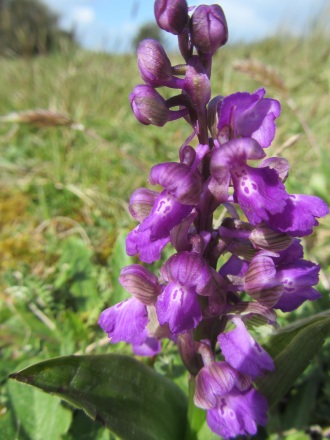
|
TUESDAY
APRIL 24 - 2018
Mystery
insect solved
I had several
replies to my query about the mystery insect I found
crawling up a signcase on Brook Meadow yesterday,
namely Ralph Hollins, Mike Wells, Tom Bickerton, Chris
Oakley and Bryan Pinchen. They all agreed that it was
a rove beetle probably Paederus
littoralis. Bryan added as a caution that
there are three species of rove beetle in the genus
Paederus and all require microscopic
examination in order to determine their
identity.

Ralph informs me that
although Paederus littoralis doesn't
look like a beetle it does have wings hidden under the
black section (wing cases) between the two red
sections and it actually flies well. He says it is
pretty common and points out that both he and I have
seen it in the past, but I don't recall that.
Apparently, it has a nasty nip and can cause skin
problems.
There are lots of images on the internet and Ralph
gave the following: showing videos and photos . . .
https://www.youtube.com/watch?v=AJWBqQNw6Js
https://www.flickr.com/photos/159639447@N06/38666627502
MONDAY
APRIL 23 - 2018
Another
swan nest failure
As previously
reported in this blog, the pair of swans on Peter Pond
that had their first nest on the island with 8 eggs in
it swamped by the high tide tried again in the reeds
in the south west corner of the pond. This looked a
better nest, but it seems to have failed like the
first one. When I passed by this afternoon, the nest
itself looked fine, but the two eggs that I saw a
couple of days ago in the nest are now out of the nest
and lying in water. The nest is in the centre of the
photo and the two eggs to the right.

What exactly happened
is a bit of a mystery. The obvious explanation is that
a high tide swamped the nest again and the eggs
floated away, much as happened with the first nest on
the island. However, the nest itself looks fine and
shows no obvious signs of having been swamped. Also,
there are a few small feathers in the cup of the nest
which surely would have been washed away with the
tide.
The best alternative explanation seems to be that a
predator, namely a fox, got to the nest and tried to
remove the eggs, but was not able to carry them away.
The nest is, in fact, close to the Gooseberry Cottage
path and a fox could have easily slipped through the
reeds to get to it.
It seems unlikely that humans were responsible as the
reeds would have been trampled and the eggs probably
removed completely.
Has anyone else any ideas what might have happened?
Extra
long catkins
The long
yellow catkins are now falling onto the ground at the
far southern end of Palmer's Road Car Park from the
tall Basford Willow trees (Salix x rubens forma
basfordiana) as they always do at this time of
the year. Have you ever seen catkins that long?

This handsome Willow
is said to have arisen sometime before 1870 as a
seedling in the nursery of the Willow-grower Mr
William Scaling of Basford, Notts, from where it gets
its name.
Mystery
insect
I had this
tiny colourful creature for company while I was
working on the signcase near the south gate to Brook
Meadow this afternoon. I photographed it crawling up
the side of the signcase. It appears to have no wings
and has lost an antenna and a front leg. Does anyone
know what it is? I will consult Bryan Pinchen.

Bluebells
galore
Maureen Power
went to West Stoke this morning and found the
Bluebells in Ashling Wood fully out, and looking (and
smelling) really good. That is a stunning view.

SUNDAY
APRIL 22 - 2018
Bridge
Road Wayside
I did the
final count of Cuckooflowers on the Bridge Road
Wayside verge for this year. I counted a total of 157
flowering plants with 76 on the north section and 81
on the south section.

Cuckooflower numbers
have been steady falling since the bumper year of 2012
when I counted 694 flowering plants. This decline
could reflect the change in grass verge management
from the regular cutting by the council to a once a
year cut as a wayside. This means that Cuckooflowers
may well benefit from regular cutting, which reduces
competition from tougher plants.
I also noted
Barren Brome grass
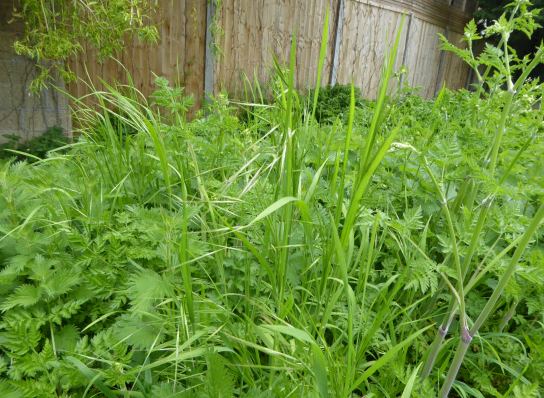
and the first signs of
Common Sorrel. The white flowers of Garlic
Mustard are now well out and prominent on the
wayside.

The small Bay bush
near the Goat Willow on the south verge is also in
flower. The only butterflies I saw were Comma and a
female Orange Tip.
Millpond
nesting news
The pen Swan
was sitting on her new nest in the reeds on Peter Pond
when I passed by this morning, looking quite settled.
She may well have laid another couple of eggs since I
last saw her.

Over to Slipper
Millpond where the pair of Coot nesting on the north
raft was on the water, presumably having lost their
first brood to the Great Black-backed Gulls. The
Canada Goose was on its nest on the centre raft
while its mate was taking a stroll along the western
path.

The Great
Black-backed Gulls seem to be well established on
the south raft, though a lady who house overlooks the
pond said she had seen a big tussle between the gulls
and a Canada Goose. But all was peaceful this morning.

Spring
flowers
The first
Herb-Robert of the year was in flower by the
Seagull Lane gate on Brook Meadow. Tree Mallow
was in blossom on the west side of Slipper Millpond.
Historical
reference to Brook Meadow
Bernard
Griffin posted a cutting onto the 'Memories of Old
Emsworth' Facebook page from the Hampshire Telegraph
for 4 Feb 1884 reporting a trial of a man named John
Hammond who was prosecuted for cruelly ill-treating a
swan by throwing stones at it and breaking its wing.
Interestingly, one of the witnesses to the incident,
Harry Ripley, told the court that he saw the defendant
throwing stones at the swan as he walked along "Mr
Reeves's footpath at Brook Meadow, Emsworth". Was that
the same Brook Meadow that we know so well? And who
was Mr Reeves?
Frances Jannaway did some detailed research on the
origins of the name 'Brook Meadow' for her book
'Brook Meadow: Through the ages'. Frances found
that the water meadows north of the railway line were
also known as 'Brook Meadow' from 1875 onwards, so it
seems likely that the reported swan incident occurred
there rather on what we know now as Brook Meadow which
is, of course, south of the railway line.
Here is the
newspaper cutting from 1884 as posted on Facebook

SATURDAY
APRIL 21 - 2018
Warblington
shore
Peter
Milinets-Raby had a walk along the Warblington shore
this morning from 6:27am until 9am. The tide was half
out and going out further. A typical early spring
morning with very little of note. If it wasn't for the
colour ringed Greenshank, the Egret & Heron
colony, the Med Gulls flying over calling and the
feeding Green Woodpecker in the paddock, it would have
been a very dull visit indeed. Just a handful of
summer migrants seen . . . .
The birds of note were as follows: Ibis Field: Singing
Blackcap, Chiffchaff and from the Cress beds a Cetti's
Warbler. 4 Med Gulls over.
Hedgerow down to Conigar Point: Singing Chiffchaff
& Blackcap. 1 Canada Goose heading west.
Mini Reed Bed by Conigar Point: 1 singing Reed Warbler
heard (first of the spring).
Conigar Point: 2 Greenshank, 1 Whimbrel (first of the
year), 5 Little Egrets, 1 Common Tern (first of the
spring), 5 Grey Plover, 1 summer plumaged Dunlin, 7
Shelduck, 2 Med Gull, 1 Lesser Black-backed Gull, 2
Black-tailed Godwit.
Off Pook Lane: one lonely Brent Goose, 2 Greenshank
(RG//- + YY//-), 9 Common Tern, 1 Chiffchaff and
Blackcap singing along Pook Lane track, 1 Black-tailed
Godwit, 8 Shelduck
Horse paddock: Female Green Woodpecker feeding on
grass (see photo).

Langstone Mill Pond:
Cetti's Warbler heard, Pair of Reed Bunting seen, 1
Reed Warbler half-heartedly singing and seen.
Grey Herons: Nest 8: (At back of Holm Oak and seen
from the paddock gate) One small juvenile seen being
fed by an adult. 2 pairs of Gadwall flying around. 1
pair of Tufted Duck
Only 17+ Little Egrets on nests - numbers have slowed
down!?
At 11:25am Peter had a
Red Kite and a Hobby soaring over the house
before they both moved off north west.

FRIDAY
APRIL 20 - 2018
Thorney
Herons and Egrets
Following the
report from Tom Bickerton in yesterday's blog about
Herons and Egrets nesting on Thorney Island, Nicola
Hammond had a walk down today to see them and got a
pleasant surprise! Nicola says the Grey Heron's nest
was huge and was mostly guarded by one Heron, although
at one point more appeared on around the nest,
including young Herons.
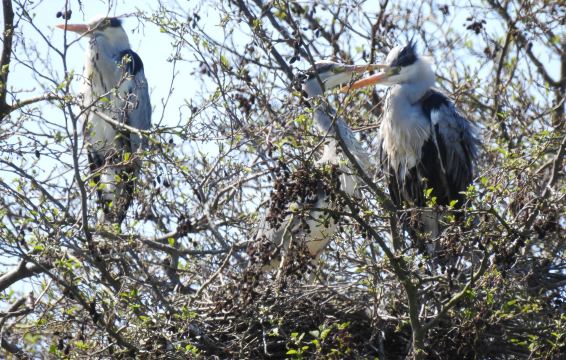
Nicola also saw two
pairs of Little Egrets actively nest building and
about another eight loafing about, maybe thinking
about it?

The Herons and Egrets
show well in the trees to the left of the track
leading from Thornham Lane to the raised footpath on
the seawall. Nicola adds you'll probably hear them
before you see them!
THURSDAY
APRIL 19 - 2018
Brook
Meadow Workday
I went over to
the meadow on a very warm and sunny morning for the
regular third Thursday in the month work session. It
was well attended by 16 volunteers and led for the
first time by Colin Brotherston (6th from the left).

Colin asked me to give
a wildlife report at the end of his briefing in which
I emphasised the need to take special care at time of
the year in disturbing areas where birds could be
nesting. The main jobs for the morning included making
a bonfire of the branches and twigs collected from
earlier work sessions and reinforcing paths and steps
with gravel.

For full report and
more photos go to . . . https://www.brookmeadow.org.uk/conservation-news/
Wildlife
observations
One of the
volunteers disturbed a Common Toad while
digging out the gravel from the bag near the Seagull
Lane gate. He placed it in vegetation nearby.
I found the first Cuckooflower of the year on
the meadow, just one above the causeway. Here is one
of the regular pair of Carrion Crows that was foraging
on the north meadow. Is he trying to say something to
me?
I spotted a lovely
spotted Brown Trout in the river beneath the
south bridge.

Not such good news
from Mike Wells who I met on the main river path. He
had just seen and photographed a Pike,
estimated length about 2 feet 6 inches, in the river
near the observation fence - bad news for hope of
Water Voles return.
In the photo look for the head of the Pike in the
lower right hand corner.

Mike also saw a Fox on
the river bank near the S-bend.
Peter
Pond swans nesting again
The swan pair
are nesting again on Peter Pond after their first nest
with 8 eggs was swamped by high tides. This time the
nest has been constructed in the reedbeds in the north
west corner of the pond. It appears to be well made
and fairly high, though I recall saying that about the
last one. The nest and sitting swan is best viewed
from the path that leads down from the main road to
Gooseberry Cottage which is where this photo was
taken.

This is fairly late
for nesting to start, but not too late. The pen swan
will lay an egg every 48 hours or so and will not
start incubation until all eggs have been laid which
lasts a further 36 days. Assuming 8 eggs are laid then
incubation should start around the beginning of May
and, if all goes well, hatching should happen at the
beginning of June.
Bridge
Road Cuckooflowers
I did another
count of Cuckooflowers on the Bridge Road Wayside this
afternoon and the total came to 136. Of these 55 were
on the grass verge north of the central shrubbery and
81 on the verge south of the shrubbery. I could see
more to come, though I reckon we may be reaching the
peak. Here is just a couple fairly close together.

Langstone
Mill Pond
Peter
Milinets-Raby briefly visited Langstone Mill Pond this
afternoon for half an hour (from 3pm) - high tide.
The Little Egrets are spreading quickly now
with 34+ birds present and 22 occupied nests, with 3
of them on the island. With the small colony at
Thorney (have you any idea on numbers so far?) It will
be interesting how many nest at Langstone this
year.
No Reed Warblers yet - getting late!! Just Chiffchaff
and a Cetti's Warbler singing.
Other birds of note included 2 Great Crested Grebes
off shore and 2 male and 1 female Tufted Duck on the
pond. The Mute Swan pair were sitting on the nest, so
all seems to be working ok.
WEDNESDAY
APRIL 18 - 2018
Hayling
Island
This morning
Jean and I had a trip down to Hayling Island. The
weather was warm and sunny, though with a strong
breeze off the sea. The sea was, in fact, extremely
rough with waves rolling in and crashing spectacularly
onto the shore. Here is a short video clip I did of
the waves . . . https://youtu.be/39B3qsloS7A
We parked on the front
at Beachlands and had a walk through the dunes where
the Gorse was in full blossom and attracting bees.
Sweet Vernal Grass was abundant everywhere alongside
the paths, mixed in here and there with Red
Dead-nettle.
Other flowers of
interest included Common Stork's-bill, Bulbous
Buttercups, Sticky Mouse-ear, Sheep's
Sorrel,
Brook
Meadow
I walked over
to the meadow this afternoon mainly to have a look for
the orchid leaves that Maurice Lillie discovered
yesterday. I found some Common Spotted Orchid
leaves on the orchid area on the north meadow.

I could not find any
Southern Marsh Orchid leaves. They are bound to be
there, but are more difficult to spot among the
widespread Great Willowherbs. While looking around the
Lumley area I came across Distant Sedge, though
it is much later than usual. Soon the whole of the
Lumley area will be covered in sedges.

I sat down for a few
minutes on the pile of grass cuttings on the east side
of the north meadow where I was entertained by two
Blackcaps singing from the copse. I managed to
get a shot of one of them singing from a Goat Willow
tree.

There were lots of
butterflies on the wing on this very warm afternoon.
Commas were particularly numerous with at least 8 seen
during my walk, usually in twos and threes chasing
each other. I also saw Brimstones, Peacocks, a Small
White and my first Orange Tip of the year. It
did not stop for a photo, but here is one taken a
couple of years ago on the meadow.

Robin Pottinger also
saw what was probably the same Orange Tip when he was
on Brook Meadow this morning. He beat me to it by a
few hours!
Swan
courtship
Brian Lawrence
got some excellent photos of the Mute Swan pair
displaying on the town millpond. That's all very well,
but why don't they go off to find a decent nesting
place rather than hang around the totally unsuitable
millpond.
Mallard
ducklings
Christopher
Evans spotted what I think is the first Mallard family
with mum and 4 ducklings in the Langbrook Stream near
the Premier Inn.

Egret
and Heron nests at Thorney
Tom Bickerton
went down to North Thorney from Emsworth today. On the
way, he saw lots of Grey Mullet in both Peter Pond and
Slipper Millpond. Both adult Great Black-backed Gulls
were on the south raft and the Coot on the north raft
had one chick.
On North Thorney Tom found Little Egret and Grey Heron
nests in the trees, both more visible than the
Langstone colony. He also had 2 blackcaps, 1
chiffchaff and 2 Cetti's warblers, along with assorted
Greenfinch, Robins and Hedge Sparrows.
Walking down the west side of Thorney he had 2 reed
warblers, 6 skylark, 2 Stonechats, 2 linnet and 1
Buzzard.
TUESDAY
APRIL 17 - 2018
Brook
Meadow
I scrambled
down the river bank to check the white flowers that I
had previously noticed on the edge of the river a
little way south of the north bridge. The wet habitat
suggested Wavy Bitter-cress which I confirmed
later under the microscope with 6-stamed flowers.

The Butterbur
leaves are growing fast below the seat, obscuring
the withering flower spikes. In a few weeks time,
these leaves will be huge, completely dominating the
area.

Two Song Thrushes were
singing strongly on either side of the south meadow.
A beautiful Comma
butterfly basking on a nettle leaf
in warm sunshine on the edge of Palmer's Road Car
Park.
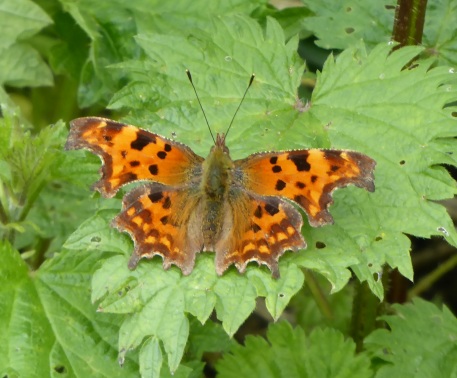
Hermitage
Millponds
I was
surprised to find the pen swan busily nest building in
the reeds in the north west corner of Peter Pond. The
cob was taking no part, snoozing on the pond. If
successful this will be their second nest, the first
having been destroyed by high tides. I recall swans
nesting in these reeds some years ago, but not this
pair.

The nesting behaviour
is better seen in this short video clip . . .
https://youtu.be/YZIPh8g5NS8
David Gattrell has
been very busy digging out new channels through the
reedbeds on the west side of Peter Pond, creating
extra wildlife habitats.

There was no change on
Slipper Millpond with Coot nesting on the north raft,
Canada Goose on the centre raft and Great Black-backed
Gulls on the north raft.
Bridge
Road Wayside
There has been
a large increase in Cuckooflowers since my last count
yesterday. Today I counted 73 Cuckooflowers on
the wayside verge with more to come. We might make the
ton! Garlic Mustard is out for the first time. I also
found some Wavy Bitter-cress with distinctive
wavy stems, growing on the edge of the Westbrook
Stream.

I found a good growth
of Keel-fruited Cornsalad in flower on the
pavement just north of my house in Bridge Road.

Langstone
Mill Pond
Peter
Milinets-Raby visited Langstone Mill Pond at lunchtime
today 12:17pm to 12:59pm - High tide and very
windy.
Peter found the Little Egret colony had
exploded into life over the last six days with just a
single bird on 11th April and today there were 33+
birds present with at least 12+ birds already paired
up and sitting on nests. Worth visiting.
The Mute Swan pair were off the nest briefly -
the nest is too much of a mound to see into (feathers
noted and a female Mallard walked up onto the nest and
nudged a couple of eggs with her bill before the Swan
returned quickly and chased the mallard off, so at
least two eggs in the nest. However, one egg was seen
outside the nest at the bottom of the mound -
obviously rolled out - well these are young
birds!!
Other species of note were: Reed Bunting heard
calling. Chiffchaff and Blackcap heard singing.
Off shore. 1 Sandwich Tern, 1 Great Crested Grebes.
Great
Tit nest building
Sue Thomas has
a Great Tit nest building in her garden. Sue hangs a
container of sheep's wool, gathered from fences and
brambles and every year some birds pull it apart for
their nests. The photo shows a Great Tit that has
found the wool and pulled a large ball onto the rose
below.

Hand
feeding Robin
Mike Wells
says that this year 'his' Robins have decided to raise
their first family in next door's garden, but guess
who is still helping with their food bill!
MONDAY
APRIL 16 - 2018
Marlpit
Lane
My first visit
of the year to Marlpit Lane was a depressing
experience. I have been visiting this little lane in
Woodmancote for over 20 years, mainly to hear the
glorious song of Nightingales, but no longer, I fear.
The destruction of the habitat which has been ongoing
for several years is now much advanced. The area to
the east of the lane where the Nightingales frequented
has been largely fenced off and is clearly occupied
judging from the substantial gates!

In addition, the
restoration work which has been going on for at least
two years on the old gravel pits site is still in full
swing. Lorries laden with soil continually trundle
back and forth along the lane, churning up the edges,
leaving the road covered with mud.

I am not really sure
what is going on, though a fellow I spoke to last year
told me they were restoring the land to grass for
grazing. At present the area resembles a large
amphitheatre with a bund around it. One notice says
'Ecological Area. Keep out'. Incidentally, I see the
old amenity tip has closed.
I managed to park on the roadside near the public
footpath entrance and gingerly made my way up the lane
where Blackcaps and several resident species were
singing, but no sound of Nightingales. Admittedly it
is still a bit early for Nightingales and numbers have
been going down over the years. However, with the
continued destruction of the habitat their return
seems doubtful.
I then walked a little way up the public footpath to
the east from where one gets a good view of the scale
of the restoration work.

There is an area at
the end of the path outside the restoration zone which
has a good compliment of bushes and trees, suitable in
principle for Nightingales. It might be worthwhile
checking this area out over the next few weeks,
probably best towards dusk when work finishes.
This area has always been good for Ground-ivy and I
was pleased to find a good flowering of this
inconspicuous plant along the footpath. I was also
pleased to see several 7-spot Ladybirds.
Bluebells
in Ashling Wood
I made my
second visit of the year to Ashling Wood to check on
the Bluebells. I parked in the Kingley Vale car park
and walked back along the lane towards East Ashling
until the footpath entrance on the right. The
Bluebells were only just starting to emerge on my last
visit on Apr 6, which actually was quite late for this
woodland which I always expect to be first for
Bluebells. Today, the Bluebells were certainly out and
widespread, though not exactly spectacular, so I
suspect there are more to come. It might be worth a
visit in a week or two.

Bridge
Road Wayside
I counted 26
flowering Cuckooflower plants on the grass
verge this afternoon. As we have had hundreds in
previous years, I am expecting (hoping for) more to
come.
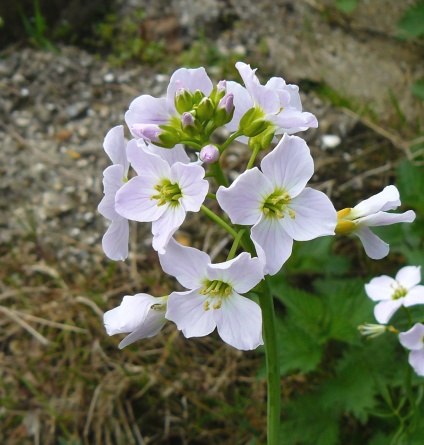
While counting the
Cuckooflowers, I came across a stunning Peacock
butterfly basking in the warm spring sunshine. These
butterflies are so beautiful they take your breath
away! A slightly less spectacular Comma was also
fluttering around the wayside. I managed to snap it
when it rested.
Slipper
Millpond news
Sharon Corbett
who lives in Slipper Road overlooking Slipper
Millpond, reports that the nesting situation has
quietened down on the pond. As last year, a Canada
Goose is sitting on the main raft and the Great
Black-backed Gulls on the south raft. Sharon adds . .
. "the male Canada Goose spends much of his spare time
with the Great Black-backed Gulls on the south raft
and they seem to get on well."
SATURDAY
APRIL 14 - 2018
Lowtons
Copse and Blagden Copse, Clanfield
The Havant
Wildlife Group had some good sightings on their
Saturday morning walk. They included Moschatel and
Toothwort plus a Tawny Owl.
Moschatel . . . .
. . . . . . . . . . . . . . . . . . . Toothwort

Photo by Derek
Mills
FRIDAY
APRIL 13 - 2018
Brook
Meadow
I had a slow
walk through the meadow down to Slipper Millpond.
Nothing very special to report. Plenty of birdsong,
with at least 3 Blackcaps singing. Meadow
Foxtail is out on the north meadow a bit later
than usual. Common Comfrey with purple flowers
is out on the river bank.
Silverweed leaves are
now very prominent on the Lumley area . . .

The fallen tree on the
river continues to attract walkers who stop to listen
to its rippling.
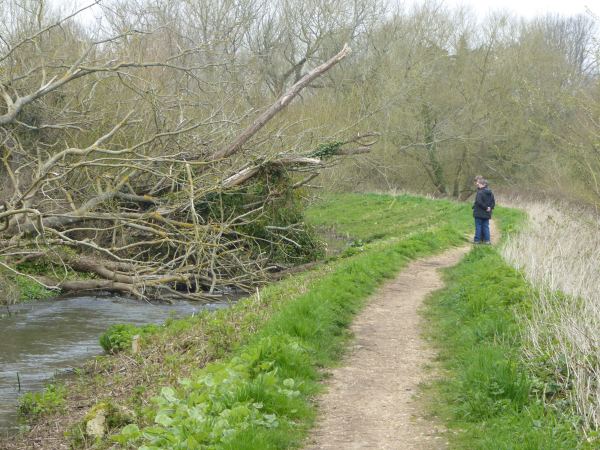
There is no change in
the nesting situation on the Hermitage Millponds, with
Coot, Canada Goose and Great Black-backed Gulls
seemingly well established.
I stopped at the
Railway Wayside on the way home. I found just a few
Coltsfoot flowers struggling for life among the
brambles and litter.

THURSDAY
APRIL 12 - 2018
Bridge
Road Wayside
I spent most
of this afternoon installing and cleaning the waysides
signcase which has not been touched for over a year. I
have completely updated the display, including
information about the Friends of Emsworth Waysides
scheme, a map of the existing wayside sites and photos
of volunteers, visitors and wildlife (birds and wild
flowers), that can be seen on the Bridge Road wayside.
Here is a photo
of the display in the signcase

I also did a mini
litter pick, just concentrating on the wayside,
producing one bag.
Following that I did a
wild flower survey of the wayside, during which I
found the first Cuckooflower of the year in
full flower, though this is one to two weeks later
than usual. It is just south of the central shrubbery.
I noted many more in bud, still to flower, so
hopefully we shall get another good showing of this
attractive flower. Last year I counted a maximum of
268 Cuckooflowers on the wayside, though numbers have
been falling since the bumper year of 2012 when I
counted an astonishing 694. Bridge Road Wayside is the
best local site that I am aware for this attractive
wild flower. It gets its name from the arrival of the
first Cuckoo, though the flower usually comes before
the bird.
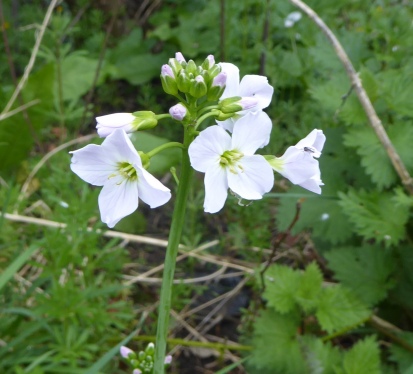
As usual in early
spring, there has been an excellent showing of the
yellow flowers of Lesser Celandine
(Wordsworth's favourite flower) beneath the Beech
hedge at the southern entrance to the car park. The
Rowan tree on the southern grass verge immediately in
front of the Celandines was planted on 4th April 2010
by Brendan Gibb-Gray in memory of his wife Margaret.
Brendan was one of the founder members of the Friends
of Emsworth Waysides in 2009.
One other significant
finding in today's survey was the first spike (flower)
of the grass Meadow Foxtail. This is also about
a week later than usual. No other grasses are out on
the wayside apart from the ubiquitous Annual
Meadow-grass.
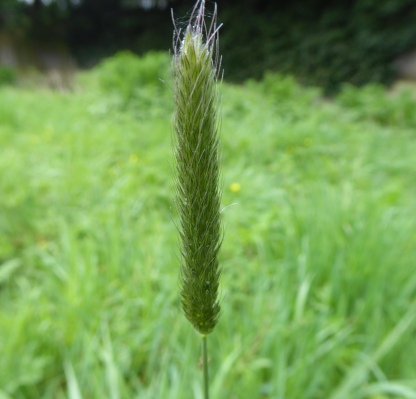
WEDNESDAY
APRIL 11 - 2018
Brook
Meadow
It was a
lovely spring-like morning for my regular walk through
the meadow. I kept to the main paths as the meadow
itself was very wet and muddy after heavy overnight
rain. The north path is looking particularly beautiful
at this time of the year.

The River Ems is
flowing very well after the rain, with water rushing
through the branches of the fallen tree, producing an
attractive rippling sound.

Most of the regular
birds were singing well, including one Chiffchaff and
one Blackcap on the north meadow. I was interested to
see a pair of Magpies feeding on the grassland in the
north meadow - not a common sight.

There was a
beautiful Peacock butterfly scuttling around in the
nettles by the north bridge, probably just awoken from
its winter slumber. I also spotted a yellow male
Brimstone fluttering around by the Lumley gate.

Entering through the
gate at the end of Seagull Lane my attention was
attracted by a patch of flowering Ivy-leaved
Speedwell which stretched northwards from the gate
along the edge of the newly laid hedgerow. The is a
regular spot for this attractive, though inconspicuous
flower with tiny pale blue flowers and hairy
ivy-shaped leaves. I also found some Common Field
Speedwell on the Seagull Lane patch close to my
Oak.
Ivy-leaved
Speedwell . . . . . . . Common Field Speedwell
I noticed buds on Cow
Parsley are about to burst into life in several areas
of the meadow. In a few weeks time, there should be a
spectacular avenue of this aromatic umbellifer
(sometimes called Queen Anne's Lace) along the main
river path.
The brown spikes of Lesser Pond Sedge are now
showing very well along the western bank of the river
just north of the observations fence.

Millpond
nesting news
The Mute
Swan nest on the Peter Pond island that was
recently swamped by high tides is now well and truly
abandoned. The swan pair was on the neighbouring
Slipper Millpond this morning, but without any clear
nesting intentions, though swans have nested on the
east bank of that pond in the past.
A Canada
Goose is now well established on a nest on the
large centre raft.

The Great
Black-backed Gulls were on the south raft with one
bird definitely sitting on a nest for the first
time.
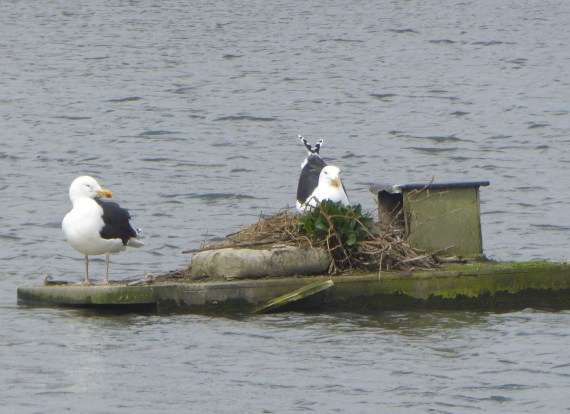
The regular Coot is on
its nest on the north raft.

Hampshire
Farm
Brian Lawrence
had a walk around a very wet Hampshire Farm this
morning where he saw and photographed a Grey Heron
fishing in the lake and a Kestrel hunting.
Langstone
Mill Pond
Peter
Milinets-Raby sends sightings from the last two day's
visits to Langstone Mill pond. Today Peter walked in
via Wade Lane and added 1 Mistle Thrush, 2+ singing.
Chiffchaff and singing Blackcap.
Flooded Horse paddock : 2 Coot, 8 Moorhen, 1 Stock
Dove, 5 Teal (only 4 on the low tide shore yesterday
and not present on the paddock). 1 Little Egret (8
yesterday, with a further 4 on the pond loitering with
intent - just one today, ). Blackcap and Chiffchaff
singing.
Off shore; 7 Red Breasted Merganser, Only 19 Med Gulls
(55+ yesterday calling constantly), 2 Greenshank (G//R
+ BR//-), 95 Black tailed Godwit (137 yesterday - B//R
+ WG//- & B//R + BN//- & B//R + LG//- &
B//R + LN//-) Two previous sightings of WG in 2014 and
2015 and one sighting of LN in 2017. Other two birds
are new to me!!!
6 Shelduck, 1 lonely Brent Goose, 4 Bar tailed Godwit
(8 yesterday ), 2 Great Crested Grebe.
Pond: Just one Little Egret in the Holm Oak - looking
settled by a nest (This bird present yesterday when
displaying to a second bird). Cetti's Warbler heard
& Chiffchaff & Reed Bunting. Mute Swan on nest
in reeds at the rear of the mill. Other pair of Mute
Swan still out on the island in the middle of Sweare
Deep. Additional birds included 2 displaying
Sparrowhawk and a single Swallow headed north.
MONDAY
APRIL 9 - 2018
Langstone
Mill Pond
Having
returned from a family holiday to The Netherlands
(best birds were 150+ Avocets, 1500+ Barnacle Geese, 3
Spoonbill and 2 Great White Egrets), Peter
Milinets-Raby is back on home territory. He says, "It
was good to be back and have a walk around the
Langstone Mil Pond, albeit in the drizzle! (9:50am to
11:12am).
Tide out (off shore). 86 Med Gulls in the channel
together having just flown off the field at
Warblington, plus a further 27 elsewhere along the
Sweare Deep. 7 Red Breasted Merganser, 95 Black-tailed
Godwit, 2 Greenshank (G//R + BR//-), 4 Teal, 10
Shelduck, 1 Great Crested Grebe, 7 Bar-tailed Godwit,
1 Lesser Black-backed Gull, 2 Mute Swans trying to
build a nest on the island - silly as it disappears
when the 4.5+ metre high tides arrive!
Off Conigar Point: 5 Shelduck.
On the Pond: 2 Chiffchaff singing, Willow Warbler
heard singing at the rear of the pond, Cetti's Warbler
Heard singing, Reed Bunting singing, 1 Little Egret
roosting in the Holm Oak?
Heronry:
No. 1: Three juvs. Adult trying to chase them off the
nest with very aggressive attacks!!
No. 2: What looks like two juveniles stood on the
nest, but not moving much in the drizzle
No. 10: Adult sat on nest
No. 4: Adult stood on nest.
No. 11: Can not see, but should have young soon
No. 7: Adult sat on nest
Nest 9 is now being labelled nest 9a as the old nest
nine has been built up over the last week and has an
adult sat on it, only metres below old nest 9.
Nest 9a: Has an adult sat on it and should have
young.
No. 8: Adult sitting - only viewed from the paddock
gate.
NEW NEST Number 12: At the rear of the Holm Oak beyond
nest 8. Has an adult sitting on it.
Paddock: 3 Little
Egrets, 1 Green Sandpiper, 7 Moorhen, 1 male
Pheasant.
I bumped into a fellow birder who had walked from
Emsworth and reported 2 Yellowhammers in the Rape
field seen from the north path at Nore Barn.
Nore Barn - 11:20am to 12:45pm. North path
mostly. 2 Med Gulls. 1 Swallow, No sign of the
Yellowhammers. However, I did see 2 Chiffchaff, 3+
Blackcap (one singing), 4+ Chaffinch, 2 Greenfinch, 1
Great Spotted Woodpecker and heard Green
Woodpecker.
AND, there are FOUR Rook nests in a tree on the
south west side of the wood.
This prompted me to check the Victoria Road Rookery
where I found 17 occupied nests
First
Swallow
Susan Kelly
had her first Swallow of the year today, probably the
same one that Peter Milinets-Raby saw at Nore Barn
earlier. It whizzed past her as she was walking in a
drizzly mist from Nore Barn to Langstone. She thinks
it should have turned round and headed back to Africa.
Drip, drip. I wonder if the Swallows are back on their
traditional nesting site in the stables at the old
Marina Farm, North Thorney? I must check.
THURSDAY
APRIL 5 - 2018
Brook
Meadow
It was a
lovely spring-like morning for my regular walk through
Brook Meadow. It was good to meet my neighbour Anne
Williams on the main river path. Anne was very
impressed with the group's clearance of the river
banks and was delighted to be able to get a nice view
of the river again! It is flowing very well at the
moment following recent rainfall. We both offered a
prayer for the return of Water Voles! PS - The photo
shows Pam from the conservation group, not Anne!

It was also good to
meet my old friend Brian Lawrence who I had not seen
on the meadow for a while. Brian sent me a few photos
he had got during his morning walk, including this
superb Robin singing its heart out.

In fact. it was a
great morning for birdsong with Wren, Dunnock,
Blackbird and Woodpigeon all singing well. But best of
all were my first Chiffchaff and
Blackcap of the year, both a bit later than
usual. I did not see either of these birds, but here's
a couple of pictures of them singing from previous
years.
Brian also took this
sneaky shot of me looking typically gormless while
leaning on the observation fence looking in vain for
Water Voles. Thanks, Brian!

I was half expecting
to see butterflies on such a nice day, but I only saw
a single Comma fluttering low in grasses.

Brian Lawrence did
much better getting shots of our first Small
White of the year and an interesting view of a . .
. I will leave you to guess this one.
The brown spikes of
Lesser Pond Sedge are now out on the river bank
north of the observation fence. These are out at about
the expected time, but surprisingly there is not sign
of spikes on the normally earlier Greater Pond Sedge
near the Lumley Stream and on the Lumley area. There
is no sign of any sedge spikes either which are often
showing at this date. It does seem to be a latish
spring.

Hermitage
Millponds
The swan
nest on the Peter Pond island was a very sad sight
indeed. The original nest was barely visible beneath
the water with just 2 of the original 8 eggs inside
it; another 3 eggs were visible floating in the water
nearby. Meanwhile, the pen and cob swans were on the
water being fed by visitors. I don't see any realistic
hope for the original nest and eggs. It seems unlikely
the swans will build another one, but you never know!
There was an
interesting development over on Slipper Millpond where
a Canada Goose (presumably one of the pair that
is nesting on the centre raft) was standing supreme on
the south raft where only yesterday I saw the pair of
Great Black-backed Gulls in residence and apparently
nesting. You can see the result of their nest building
effort in the photos.

What is going on? Has
the Canada Goose done another take-over and ousted the
large gulls? I just can't believe this, but it
happened last year when the Canada Geese took over the
centre raft where the Great Black-backed Gulls had
nested for the previous 5 years.
WEDNESDAY
APRIL 4 - 2018
Brook
Meadow
Having fallen
twice in the past few months requiring A&E
treatment, I was extra cautious this morning in
walking through a very wet and windy Brook Meadow to
the Hermitage Millponds. I listened for Chiffchaff and
Blackcap which I often hear for the first time about
now, but there was no sound of either. I also looked
along the recently cleared river banks for any sign of
Water Voles, or even Water Rail that I saw last week,
but without any luck.
Peter
Pond swans
Going across
the small footbridge to the north of Peter Pond, I
noticed a well established Coot nest on the edge of
the reeds in main channel.

As for the Peter Pond
swans, they were away from their swamped nest site.
The pen was swimming around on the water near the seat
with her mate, the cob, standing imperiously on the
bank. It always surprises me (but shouldn't, I know)
how little affected birds are by what seems to us
humans as tragic losses; they just carry on as if
nothing had happened.

The old nest site, as
viewed from the roadside, was totally inundated, but
the 5 eggs I saw yesterday were still visible in the
remnants of the nest. I need to find out how long the
eggs remain viable in the absence of incubation.

Slipper
Millpond nesting
In sharp
contrast to Peter Pond, nesting was in full swing on
Slipper Millpond. The regular pair of Coots is well
ensconced on a twig nest on the north raft, but
outside the too-small nest box.

A pair of Canada
Geese is back on the centre raft as they were last
year with one bird already settled down on a nest on
the raft with its mate in the water. Last year they
raised 5 goslings, but then quite suddenly disappeared
in mid-May and were not seen again.

Meanwhile, the
Great Black-backed Gulls are having to make do
with the smaller south raft as they did last year when
they were ousted from their usual nesting site on the
centre raft by the Canada Geese. Both gulls were
present on the raft this morning with a large pile of
twigs indicating nest building activity, but no
sitting as yet.

TUESDAY
APRIL 3 - 2018
Swan
nest swamped
Dan Mortimer
e-mailed me this morning with the news that the Mute
Swan nest on the Peter Pond island had been swamped
overnight by the high tide and that their 8 eggs were
all floating in the water. I went down later in the
morning to find the swan pair busy at the nest site,
the pen forlornly trying to retrieve the eggs from the
water, while the cob just messed about moving bits of
twig around. I could see 5 eggs in the water on the
remains of the nest. The pen tried to sit on them but
without success.

Here is a short video
of the swans at the nest . . . https://youtu.be/NrY0owIhw5A
I popped down to Peter
Pond have another look at the nest site at about 6pm.
Both swans were on the pond, but the nest site was
totally under water with a few eggs just visible in
the water. It is not easy to see how the nest can be
built up again with the original eggs, but with swans
you never can tell. So, keep a look out.

Garden
Pheasant
Keith Wileman
had this handsome lady Pheasant in his garden today.
What a nice surprise. They do wander at this time of
the year.

SUNDAY
APRIL 1 - 2018
Garden
birds
I have had two
firsts in my Emsworth garden over the past two days.
Yesterday, a pair of Herring Gulls swooped down
to pick up some morsels of bread I had thrown onto the
lawn. Black-headed Gulls are fairly common in the
garden if I put bread down, but these were my first
ever Herring Gulls in my 20 years in this house. What
whoppers! Definitely the biggest birds I have had in
the garden. I did not get a pic of the Herring Gulls
as they were far too fast for me. However, I did find
the following photo in my library of two that visited
Patrick Murphy's garden a few years ago. Sadly,
Patrick died a couple of years ago.

I did manage to get a
quick picture of two male Blackcaps on the
fatball feeder together. I frequently see Blackcaps in
the garden at this time of the year, sometimes male
and female, but, this was, as far as I can recall, the
first time I have seen two males together. I assume
these two chaps are part of the wintering population
that will soon be returning to their breeding grounds
on the continent.

Also, in the garden
today was a Stock Dove, not that unusual a garden
visitor these days, but nice to see all the same. Here
it is in company with a Woodpigeon for a nice
comparison. Such a gentle looking bird.
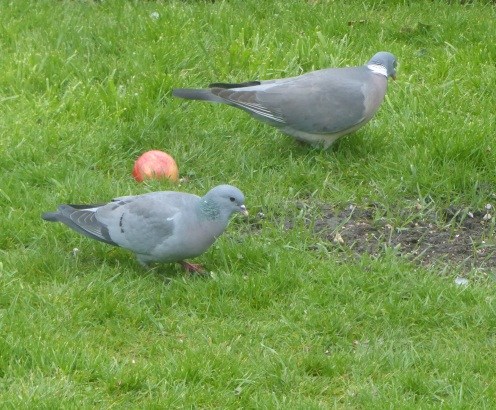
For
the previous month go to . . . March
2018